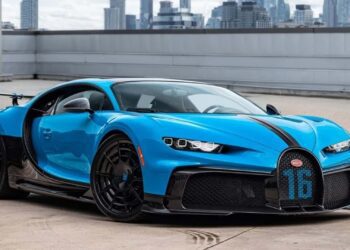You’re living at the same time as the Bugatti W16 engine.
And that’s really saying something, because the W16 engine is the only 16-cylinder engine in the world to be used in a car, and with the industry moving toward hybrid and electric power, it’s likely that it will stay that way. Introduced to the world in 2005, the end of the W16 era may be upon us, but the innovation that it took to implement such an engine is still much more than impressive to this day. Both the engine and everything around it made for a once-in-a-lifetime moment for the car world, and that splendor is something that simply can’t be replicated.
MUST READ: Bugatti Chiron vs Bugatti Veyron: And The Winner Is…
The design for the W16 started life as a drawing on an envelope, done by Ferdinand Karl Piech in 1997 as he was on the Shinkansen train from Tokyo to Osaka. What he drew was a W18 engine, but it was eventually downsized to a 16-cylinder engine after concept cars and testing. However, the challenges were only beginning, as once the engine was greenlit for production, an entire car had to be engineered to meet its radical demands. Before the Bugatti Veyron, no car had used an engine like that one, and no roadgoing car had reached its level of speed, so Bugatti’s engineers had to go from the ground up.
The W16 engine produced an incredible 987 horsepower and that engine needed unprecedented levels of cooling and ventilation. Everything down to the test bench for the engine had to be redeveloped, and after years of development, a system was developed in which nearly 15 gallons of water is used to cool the engine. With 16 cylinders, it was also difficult to detect a misfire as the engine is predisposed to run smooth, which called for the development of Bugatti Ion Current Sensing to monitor each spark plugs ion current flowing to make sure the engine is running properly. This took years to finalize for the Bugatti Veyron that changed the world in 2005, and it was improved in 2010 for the Veyron Super Sport, in which it made 1,184 horsepower.
Then, the engine was developed to be even better for the Chiron, where it made an absolutely unfathomable 1.479 horsepower. At that point, Bugatti had much more experience and expertise with the W16 powertrain and was ready to make something even more incredible. With the new innovation of sequential turbocharging, the Chiron’s performance was upgraded even further for the Super Sport model, and the Super Sport 300+ broke the 300 mph barrier. As the era of the W16 engine may be coming to an end soon, much of the world still hasn’t caught up to its game-changing innovation, and Bugatti is ready to be even more ahead of its time than it has been before.
Source: Bugatti




















